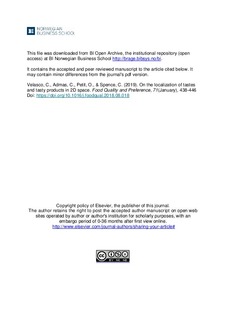On the localization of tastes and tasty products in 2D space
Journal article, Peer reviewed
Accepted version
Permanent lenke
http://hdl.handle.net/11250/2562407Utgivelsesdato
2019Metadata
Vis full innførselSamlinger
- Publikasjoner fra CRIStin - BI [1013]
- Scientific articles [2173]
Originalversjon
Food Quality and Preference, 2019, 71(January), 438-446 https://doi.org/10.1016/j.foodqual.2018.08.018Sammendrag
People map different sensory stimuli, and words that describe/refer to those stimuli, onto spatial dimensions in a manner that is non-arbitrary. Here, we evaluate whether people also associate basic taste words and products with characteristic tastes with a distinctive location (e.g., upper right corner) or a more general direction (e.g., more right than left). Based on prior research on taste and location valence, we predicted that sweetness would be associated with higher vertical spatial positions than the other basic tastes. The results of Experiments 1 and 2 support the view that participants do indeed locate the word “sweet” higher in space than the word “bitter”. In Experiment 2, the participants also positioned products that are typically expected to be sweet (cupcake and honey) or bitter (beer and coffee) spatially. Overall, the sweet-tasting products were assigned to higher locations than were the bitter-tasting products. In order to test whether taste/location congruency would also affect product evaluations, a third experiment was conducted. The results of Experiment 3A (between participants) and 3B (within participants) failed to provide any evidence for the existence of consistent taste/location congruency effects. However, in Experiment 3B, the participants evaluated the sweet products as looking more appetizing when presented in upper relative to lower shelf locations. In none of the three studies was an association found between tastes and positions along the horizontal axis. Taken together, these results suggest that sweet and bitter tastes are differentially located in vertical, but not horizontal, space. The potential implications of these findings for both our understanding of the crossmodal correspondences, as well as for taste evaluation, and product placement are discussed.
